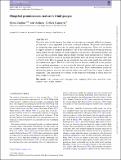Files in this item
Slingshot prominences : nature’s wind gauges
Item metadata
| dc.contributor.author | Jardine, Moira | |
| dc.contributor.author | Collier Cameron, Andrew | |
| dc.date.accessioned | 2018-11-22T16:30:09Z | |
| dc.date.available | 2018-11-22T16:30:09Z | |
| dc.date.issued | 2019-01-21 | |
| dc.identifier | 256668487 | |
| dc.identifier | e326d612-5ba1-4aa9-aa4a-23c4bbdd2174 | |
| dc.identifier | 85064139745 | |
| dc.identifier | 000462312600001 | |
| dc.identifier.citation | Jardine , M & Collier Cameron , A 2019 , ' Slingshot prominences : nature’s wind gauges ' , Monthly Notices of the Royal Astronomical Society , vol. 482 , no. 3 , pp. 2853-2860 . https://doi.org/10.1093/mnras/sty2872 | en |
| dc.identifier.issn | 0035-8711 | |
| dc.identifier.other | crossref: 10.1093/mnras/sty2872 | |
| dc.identifier.other | ORCID: /0000-0002-8863-7828/work/58531377 | |
| dc.identifier.other | ORCID: /0000-0002-1466-5236/work/57821841 | |
| dc.identifier.uri | https://hdl.handle.net/10023/16527 | |
| dc.description | We acknowledge funding from the Science and Technology Facilities Council consolidated grant ST/R000824/1 | en |
| dc.description.abstract | Mass-loss rates for the tenuous, hot winds of cool stars are extremely difficult to measure, yet they are a crucial ingredient in the stars’ rotational evolution. We present a new method for measuring these mass-loss rates in young, rapidly rotating stars. These stars are known to support systems of ‘slingshot prominences’ fed by hot wind material flowing up from the stellar surface into the summits of closed magnetic loop structures. The material gathers and cools near the co-rotation radius until its density becomes large enough that it is visible as a transient absorption feature in the hydrogen Balmer lines and strong resonance lines such as Ca ii H & K. Here we present the key insight that the sonic point usually lies well below the condensation region. The flow at the wind base is therefore unaffected by the presence of an overlying prominence, so we can use the observed masses and recurrence times of the condensations to estimate the mass flux in the wind. These measurements extend the relationship between mass-loss rate per unit surface area and X-ray flux to span 5 orders of magnitude. They demonstrate no evidence of the suspected weakening of stellar mass-loss rates at high X-ray flux levels. | |
| dc.format.extent | 1466217 | |
| dc.language.iso | eng | |
| dc.relation.ispartof | Monthly Notices of the Royal Astronomical Society | en |
| dc.subject | Stars: coronae | en |
| dc.subject | Stars: late-type | en |
| dc.subject | Stars: magnetic field | en |
| dc.subject | Stars: mass-loss | en |
| dc.subject | Stars: rotation | en |
| dc.subject | Stars: winds, outflows | en |
| dc.subject | QB Astronomy | en |
| dc.subject | QC Physics | en |
| dc.subject | NDAS | en |
| dc.subject.lcc | QB | en |
| dc.subject.lcc | QC | en |
| dc.title | Slingshot prominences : nature’s wind gauges | en |
| dc.type | Journal article | en |
| dc.contributor.sponsor | Science & Technology Facilities Council | en |
| dc.contributor.sponsor | Science & Technology Facilities Council | en |
| dc.contributor.institution | University of St Andrews. School of Physics and Astronomy | en |
| dc.contributor.institution | University of St Andrews. St Andrews Centre for Exoplanet Science | en |
| dc.identifier.doi | 10.1093/mnras/sty2872 | |
| dc.description.status | Peer reviewed | en |
| dc.identifier.grantnumber | ST/M001296/1 | en |
| dc.identifier.grantnumber | ST/R00824/1 | en |
This item appears in the following Collection(s)
Items in the St Andrews Research Repository are protected by copyright, with all rights reserved, unless otherwise indicated.

